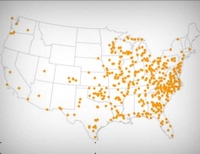Political blogger identifies first step towards ending prison-based gerrymandering in Arizona
Blogger asks citizens to urge the Arizona Independent Redistricting Commission to release the data needed to bring an end to prison-based gerrymandering.
by Leah Sakala, August 22, 2011
BlogforArizona.com blogger “AzBlueMeanie” has recently written a series of posts about the problem of prison-based gerrymandering in Arizona. Not only are the posts excellent, but they are also timely, as the Arizona Independent Redistricting Commission (AIRC) is currently holding a series of public hearings to get feedback before drawing state redistricting maps in the near future.
- In the first post, AzBlueMeanie gives a general overview of why prison-based gerrymandering is a problem for Arizona’s democracy, using our materials to illustrate the issue.
- In the second post, AzBlueMeanie urges readers to raise the issue of prison-based gerrymandering at the Redistricting Commission’s public hearings, pointing to our Arizona page as a resource for supporting documents.
- Finally, AzBlueMeanie’s third post makes the great recommendation that Arizona citizens ask the Redistricting Commission to specifically identify incarcerated populations in the draft maps that they release to the public:
The key to your testimony at Arizona Independent Redistricting Commission (AIRC) public hearings is to request that the AIRC flag these census tract/blocks for prisons in their reports and identify incarcerated populations on the draft district maps under discussion so that they are readily identifiable to the public. This will facilitate knowledgeable public discussion, and will build a public record for Department of Justice Voting Rights Section preclearance of district maps, and a public record for any potential litigation.
AzBlueMeanie could not be more right.
Redistricting maps are hard to parse and analyze without detailed—and useful—summary data to accompany them. Accordingly, most redistricting committees produce summary tables with key demographics for each mapped district: race, ethnicity, voting age population, etc. In Arizona, a healthy discussion about proposed districts needs to include information about the number of people incarcerated in each district.
The Redistricting Commission isn’t, this decade at least, going to follow New York or Maryland and count incarcerated people at home. But, with some careful planning, they can minimize the effects of prison-based gerrymandering right now.
The Census Bureau is now making it easy for redistricting technicians to know which populations in their data are in fact incarcerated. But empowering the Arizona public to give meaningful feedback on the draft maps remains the job of the Arizona Independent Redistricting Commission. True, residents of Arizona could hire demographers to perform analyses of draft maps to evaluate the extent of prison-based gerrymandering, but this is data that the Commission should already have at its fingertips. The public should take AzBlueMeanie’s advice and urge the Arizona Independent Redistricting Commission to include data on the number of incarcerated people in their demographic summaries of each draft district.




[…] article raising the issue in Phoenix Magazine, and as I blogged last month, AZBlueMeanie has been writing about the problem on Blog for Arizona. There has also been repeated detailed testimony at Commission meetings from […]